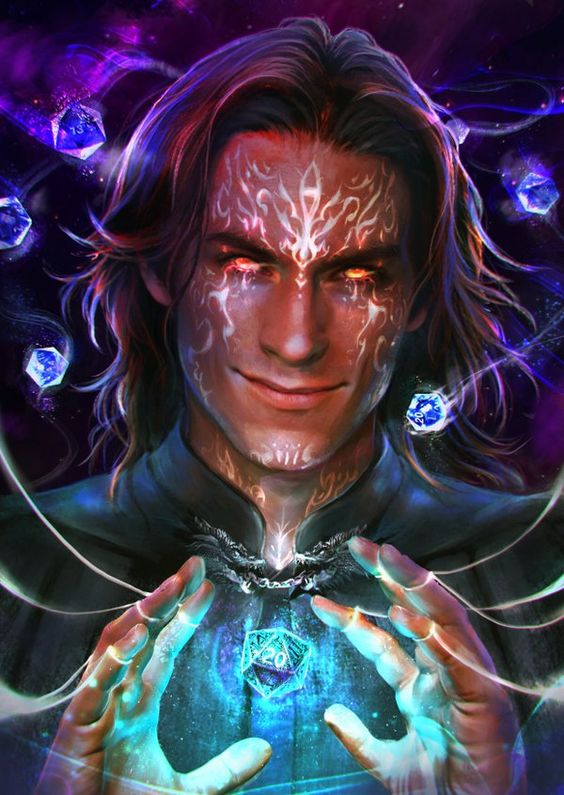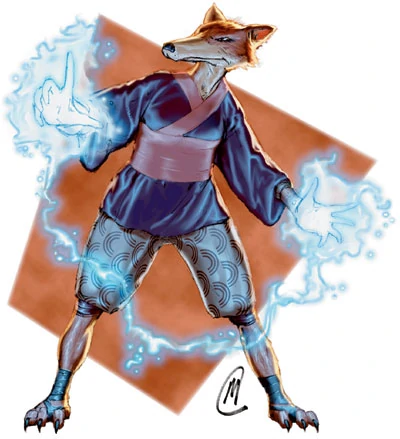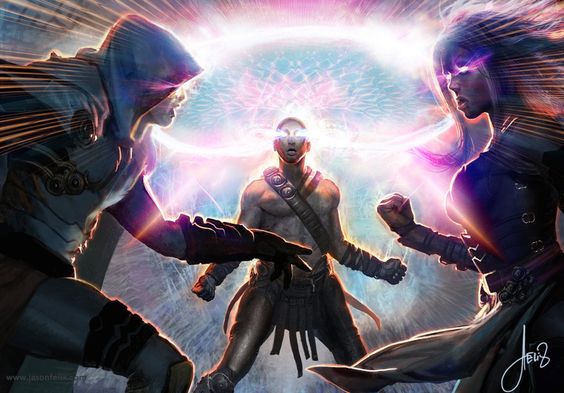Dungeons and Dragons are home to many fantastical creatures — from the titular dragon to the lesser-known Rust Monster. These creatures come in all shapes and sizes. Armed with supernatural abilities, they are a far cry from the animals that we see in our world. Kind of like how a mantis shrimp can see more colors than we can, creatures in D&D can see more things than we can.
I’ve been a Dungeon Master for close to a decade and have been a player for much longer. I started in the 3.5 edition and moved to 5th edition when it came out. I have branched out and tried various other systems like FATE core, Warhammer, and Blades in the Dark.
Creating my homebrew campaign has led me to read into the minutiae of monsters and the world of the Forgotten Realms. I have acquired extensive knowledge on the topic, from creatures to spell effects.
With that in mind, in this Truesight 5e guide, we’ll talk about Truesight and the spell True Seeing.
Bottom Line Up Front
Truesight is a type of vision that allows the user to see the original form of anything within sight. It is common to see the range being short, around 30 to 60 feet.
In the game itself, this allows the watcher to:
- Peer through magical Darkness as well as regular Darkness.
- See invisible objects and creatures as if the spell did not hide them.
- Detect Illusions and immediately succeed on the saving throw against them.
- See the original form of Shapechangers
- See within the Ethereal Plane
Truesight pairs with strong monsters meant for high-level players to defeat. While players have access to this through D&D Spells, this is to see hidden areas and invisible creatures.
Truesight (vision)

In D&D, there are many different types of senses to perceive. The most extraordinary is Truesight because this sense encompasses all the other sights.
It’s limited to a short range but gives almost omnipotent vision within its range. Even the ability to see magic itself as something visible yet still ethereal.
Here is the list of sight types if you are curious:
- Normal Vision
- Dim light Vision
- Dark Vision
- Infrared Vision
- Tremor Sense
- Blind Sight
- True Sight
Particular creatures can also detect presences through smell and hearing. When it comes to perception checks, it will always say what sense the creature is using. If you are the DM, you have to distinguish between the senses of the players. When it comes to monsters, rely on what senses they have available.
So let’s talk about Truesight.
We see the world in colors and can distinguish shape and distance from our normal vision. We cannot see in Darkness; even in the dim light, we struggle unless we have acclimated to the Darkness. Truesight allows the viewer to see things we cannot. From seeing in Darkness to viewing other planes of existence, Truesight provides many effects.
Let’s break down what Truesight does and how it affects the game.
See Through Magical and Ordinary Darkness

In D&D, there are two kinds of darkness. The first is natural darkness caused by a lack of light, for example, nighttime or wandering in a dark cave. Darkvision would be enough to see as if it was in daylight, yet seeing in only whites, blacks, and greys. Darkvision does not allow you to see through magical darkness. So what is magical darkness, you may ask?
Magical darkness is darkness created by a spell or similar magical effect. The 2nd level spell “Darkness” makes this magical darkness, for example. Aside from that, several fiends and devils also can create magical darkness. It is a zone where no light can enter; it is a 2nd level spell that has the caveat of breaking with stronger light magic. Darkvision cannot see in the zone of darkness, and nothing can empower the vision to see through it.
Yet, Truesight can see through both types of darkness as if it were daytime.
See Invisible Objects and Creatures
With Truesight, you can see these objects and creatures as if they were not invisible. While it is straightforward, Truesight even sees through the higher-level spell Greater Invisibility. Which generally would maintain the invisibility spell no matter the circumstance. It does not reveal the creature; rather, you see through the veil covering them.
Ironically, it is as if the user never cast a spell on them, so they may not recognize that they are invisible. I would describe the invisible target as coated in a misty veil. Rules as written, there isn’t anything covering them.
Interaction-wise, it does not see through the complete stealth made by invisibility. It also does not see through objects, so if the invisible hider is behind something solid, the perceiver must still succeed in the spotting check to find the hidden target.
Automatically See Illusions and Succeed on the Saving Throw
This effect applies to spells under the school of illusion and similar effects. This means that creatures with Truesight can detect the presence of an illusion. Most if not all Illusion spells have a saving throw attached to them to see through the illusion. Otherwise, even if they know that there is an illusion, they cannot tell what the illusion is.
With Truesight, you automatically detect and see through the illusion. Whether it is to disguise a person or hide an entire party, you will know that an illusion is in place and dismiss it.
I would describe it as seeing through magic — you must know the area affected to detect the illusion. Otherwise, you would not know there was an illusion.
See the Original Form of a Shapechanger

The term encapsulates changelings, lycanthropes, and other effects like these creatures. Surprisingly Shape-changing is a rare occurrence in the magic-filled world of D&D. Only found in rare creatures and powerful spells.
While a creature is in that form, it is more than an illusion. Shapechangers transform into that creature, whether it be a cat, dog, or dragon. They do not mentally change, so a dog may still have the intelligence of a human. With Truesight, you can see their original body no matter what form they take. For Changelings, it would be their pale form and a featureless face. For those afflicted with Lycanthrope, it would be the uncursed humanoid form.
What players do with that knowledge is entirely up to them. They can keep up the charade of buying into the transformation or look for a way to dispel or cure the change.
See the Ethereal Plane

The Ethereal Plane, also known as the Waveless Sea, is a plane that aligns closely with the Material Plane. (That is the central place where most adventures happen). The Ethereal is described as a mist-filled colorful plane. It mirrors the Material Plane and can even peer into it. The view blurs as in its representation in the Ethereal. You cannot interact with this plane through normal means and vice-versa.
Seeing into this plane allows you to see creatures and objects hidden within the plane, including ghosts and other spectral monsters. You can see into another location and peer into what secrets lie in store. Walls and solid objects are quite phantasmal in that plane. So with good enough eyes, you can see through almost anything.
Comparison Truesight vs Normal Sight
Truesight has a much shorter range to compensate for the variety of things it can see. From 30 to 60 to even 120 feet, it can only go far compared to the usual 400-500 feet common vision boasts.
Looking at the benefits of Truesight, it is understandable that people consider it over normal vision. So a spell that can emulate those effects is held in high regard.
True Seeing (spell)
| Casting Time | 1 Action |
| Range | Touch |
| Target | A willing creature that you touch |
| Components | V, S, M, (an ointment for the eyes that costs 25gp, made from mushroom powder, saffron, and fat, that is consumed by the spell) |
| Duration | 1 hour |

This 6th-level divination spell “gives the willing creature the ability to see things as they are. For the duration, the creature has Truesight, can see secret doors hidden by magical effects, and can see into the Ethereal Plane; all of these effects extend to a range of 120 feet.”
So yeah, on top of Truesight, this spell allows for seeing secret doors. All around, a powerful spell, even for 6th level. That would mean that a full caster would have access to it at level 11 at the earliest.
Commonly Seen In
The spell can be cast by Bards, Clerics, Sorcerers, Warlocks, and Wizards.
Any of them can learn it at level 11, and You can find it in scrolls.
For Creatures:
Greatwyrms and certain dragons such as Gem Dragons have Truesight when they are Ancient or of similar age. The young ones slowly develop into it by gaining sight and senses as they grow older.
Powerful Devils and Demons have true sight; in more detail, all the princes of hell and named Devils have Truesight. Balors, Arcanoloths, and Erinyes, to name a few species of fiends, also have this sight.
On the flip side, Angels of all power levels have true sight and a few other celestial creatures such as the Couatl and Ki-rin.

Particular named Fey creatures have Truesight, such as Bavlorna Blightstraw and Endelyn Moongrave, but it is not common for Fey to have Truesight.
Specific aberrations and monstrosities have access to Truesight, mainly powerful ones, and the occasional vision-themed monster. A few examples would be Belashyrra, Berbalang, and Nothics for aberrations. On the other hand, Monstrosities include Krakens, Nagpa, and Sphinxes.
Finally, certain undead also has Truesight, mainly Liches, Archliches, and Demi liches.
Interactions
Seeing through everything makes interactions quite interesting, especially when game mechanics clash with rulings. Let’s talk about a few exchanges that may need to be explained.
Stealth: When it comes to stealth, you can hide anywhere if you are under the effects of invisibility. So if a character hides using invisibility, they are automatically detected. However, if they use cover in conjunction with invisibility, then Truesight would not be able to see the creature automatically.
Shifted creatures: While it can see the beast’s original form. It’s hilarious to imagine a dragon in the body of a tiny mouse. I would say that they know the original body but can also see the current form, like a costume.
FAQ
Question: Does Truesight see through stealth?
Answer: No, it does not. Unless the creature uses invisibility to walk around without being seen. Stealth will hide them if they go behind total cover. Truesight does not let you see through objects. It also doesn’t enhance any other senses, such as hearing or smell.
Question: Does Truesight Prevent Blindness?
Answer: No, it does not. A creature can still be blinded even with Truesight. Truesight does not cure blindness. Casting True Seeing does not give a creature sight and only enhances its regular vision with Truesight.
Question: Does Truesight see through Fog?
Answer: No, it does not. Truesight cannot see through objects. Given that Fog, clouds of Smoke, and fumes tangibly block vision, Truesight is unable to see through it.
Conclusion
Truesight is a powerful effect that reveals many hidden aspects of the game. It’s in the name, Truesight — it shows the truth of everything to you. While it may seem near-omniscient, it is nice to see that it’s not. It has various weaknesses to make up for its powerful effects. It is a powerful effect that achieves balance despite the drawbacks the game has for it.
- Prestige Classes 5e Guide - September 20, 2022
- Rod of the Pact Keeper 5e Guide - September 15, 2022
- Sanctuary 5e Guide - September 14, 2022

